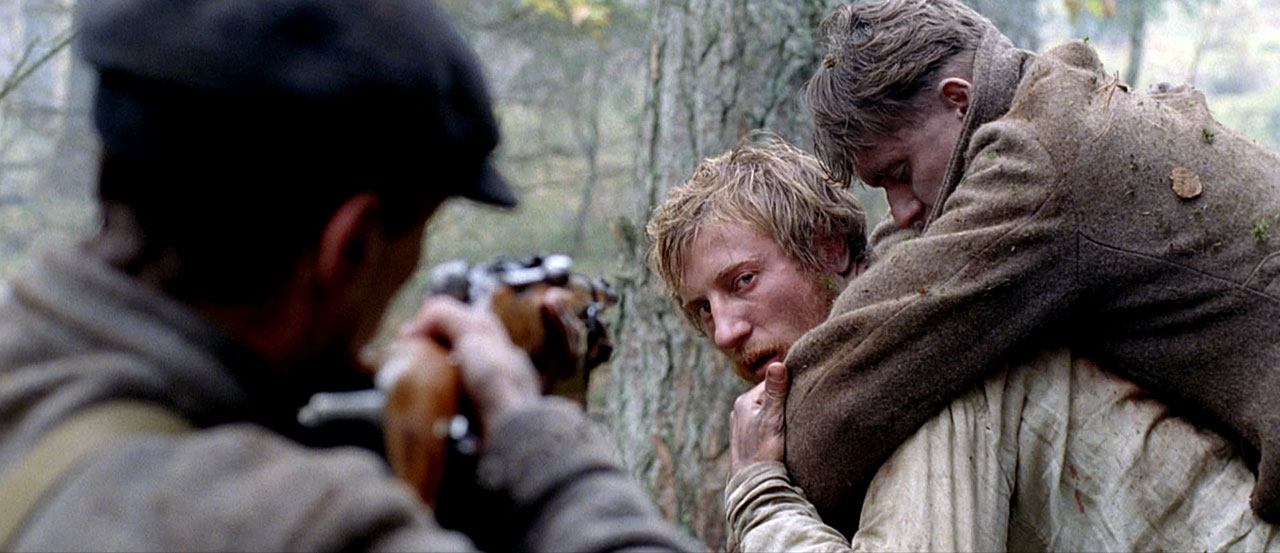In the Fog finds Sergei Loznitsa once again preoccupied with the ghosts of World War II, but this time, as in his documentary Blockade, the ghosts are in the making: still-living souls whose yearning for death is the philosophical outcome of war.
The film follows Sushenya (Vladimir Svirskiy), a railroad worker who’s caught by the Germans and later freed while the rest of his worker group is hanged, which raises the suspicions of the Soviet partisans, who decide Sushenya must be a spy (he’s not). Sushenya’s childhood friend, Burov (Vladislav Abashin), and fellow partisan Voitik (Sergei Kolesov) are then tasked with retrieving and killing him in the woods, but before Burov can shoot, the three are caught in gunfire and Burov is critically wounded. Sushenya volunteers to carry him on his back and the three try to escape while remaining on alert for more German forces. But despite the fact that the partisans trust Sushenya enough to stay with the wounded Burov while Voitik looks for a cart to carry him in, the two remain suspicious of the railroad worker.
It’s a straightforward story, but the dialogue is rich in contextual details that reveal the stripped vestiges of humanity fellow Belarusians have for each other in occupation. Such tensions emerge when Boruv first comes for Sushenya, whose wife, unaware of his impending execution, pleads that he take some food with him. Her offer underscores the details of everyday life that become utterly pointless when one is faced with death. Why waste food when Sushenya will be fed bullets momentarily? (A shot of vodka seems more appropriate, and sure enough Sushenya indulges in one last gulp).
After Burov is shot and he and Sushenya and Voitik realize that they face a grueling mission in the woods, the film launches into a series of elongated flashbacks for each of the men that outlines their individual war stories. Burov’s flashback depicts his petty need for revenge against the Germans; starved of power after soldiers forcibly take his truck (one that he built with his bare hands), he sets it on fire and plans to escape while his mother wearily reprimands him for pointlessly endangering his life. As a point of comparison, Sushenya’s flashback demonstrates his refusal to spy on his people after the Germans offer him the opportunity to stay alive provided his “secret cooperation.” The film is certainly conveying a platitudinous notion (dire situations bring out the best and worst in people), but these characters’ small, painful stories unfold with such stunningly deliberate gloom that it’s hard not to be affected by their moral quandaries.
Perhaps the obvious point of comparison for In the Fog, given the endless melancholic long shots in the woods, is the work of Andrei Tarkovsky, and it does seem to ring back to scenes from the Russian auteur’s films wherein subtle background noises like wind and crackling twigs fill in the silence for the demoralized mental operations of its characters. But unlike Tarkovsky, who left words unspoken for his characters, Loznitsa occasionally writes his ideas too explicitly in the film’s dialogue, though he makes up for this by deftly employing some ironic symbolism elsewhere. In the scene in which Sushenya turns down the German commander’s offer to work as a spy, the commander decides to let him go anyway, because he knows Sushenya’s people will turn on him. He coolly tells Sushenya to “get lost” while a bird in the office can be seen fluttering around in its cage. In the twisted manifestations of war during WWII, imprisonment and execution occasionally offered a contradictory level of comfort that freedom did not. If the bird were freed it would be eaten alive by its predators. That same fate tragically awaits Sushenya.

